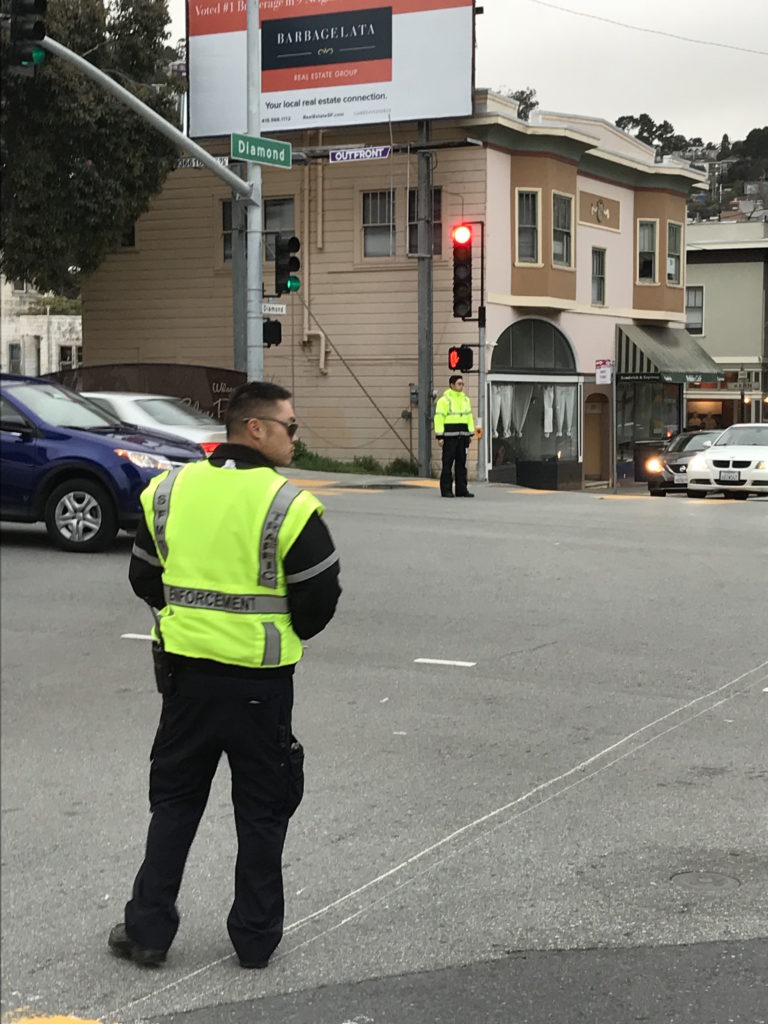To celebrate the Glen Park Association Website turning ten years old, we are reposting some of our favorite stories from the last ten years.

By Elizabeth Weise
It took nine years of planning, three years of waiting, almost $2 million to fund, a major design snafu and 16 months of soul-destroying disruption to build the new Diamond and Bosworth intersection in Glen Park.
After all that, it reopened with no fanfare or ribbon cutting, the neighborhood simply giving a collective sigh of exhausted relief that the work that had taken so long was finally complete.
That was in August of 2016.
Fast forward a year and a half. Beginning in January, at the request of District 8 Supervisor Jeff Sheehy, every weekday evening two San Francisco Municipal Transportation Agency traffic control offers are in the oft-congested intersection to deal with the potentially dangerous mix of people on foot and behind the wheel.
Sheehy, a Glen Park resident, said he asked for the human aid in the intersection because he’s seen so many near-miss pedestrian and vehicle mishaps there.
“Specifically, cars turning left from Diamond onto Bosworth in the southbound direction frequently nearly hit straggling pedestrians coming out of BART as the light turns yellow to red. Cars speed up to fly through the intersection in front of oncoming traffic (which is where their eyes are focused), pedestrians dart to get across before the light changes,” he told the Glen Park News.
“I have seen so many near misses,” he said. “I do not want to see someone killed.”
Asked about how the City could have spent nearly $2 million to create an intersection that requires two traffic cops to keep people from getting injured or killed, Sheehy said he wasn’t involved in the redesign and so can’t comment. His concern now is merely to keep the neighborhood safe.
For those who might not remember the long history of the intersection, some background:
Back in 2003, then-U.S. Rep. Tom Lantos secured $3 million in federal money to fix up the gateway to Glen Park. Lantos, whose district included part of Glen Park, passed away in 2008, but the project outlived him.
That began a nine-year planning process, which created the Glen Park Plan.
About a third of the funding was devoted to work on the Diamond and Bosworth intersection, long a bottleneck in an increasingly popular and trafficked part of town.
The traffic-snarling construction at Glen Park’s busiest intersection began on Jan. 6, 2015. The goal was to make the intersection safer for pedestrians and speedier for people traveling through it on Muni, with the full knowledge that this would create delays and backups that would be frustrating for those driving private automobiles.
“Ultimately the only way we’re going to see improvement is if there are fewer vehicles,” a City staffer told the Glen Park News in 2016.
The changes included:
- Reducing the number of lanes on Bosworth and Diamond from three to two.
- Widening the sidewalks via “bulb-outs.”
- Removing the bus stop pull-ins on Bosworth in both directions and instead having busses stop in the street.
- Building new bus shelters near the intersection, in front of Diamond Dental and the Mail Depot.
- Adding new benches.
- Adding drought-tolerant landscaping in the median of Bosworth Street.
- Adding a left-turn lane for drivers traveling north on Diamond Street onto Bosworth Street.
- Installing the Glen Park gateway sign on the corner of Bosworth and Diamond streets.
- Repaving and restriping streets.
The work was almost complete in the fall of 2015 after nine months of traffic-snarling street closures when it was discovered that SFMTA planners had made the intersection too narrow for buses and large trucks to navigate the turns without going up on the curb or onto the traffic median between the lanes on Bosworth. More than two years earlier, the Glen Park Association warned of the potential problem of the lanes being too narrow for large vehicles to navigate safely, but SFMTA staff responded at the time that the design was adequate.
This major design flaw required SFMTA to go back to the drawing board and re-do the intersection at considerable cost — an estimated $745,000 according to The Chronicle.
When the fix was finally done in August of 2016, the intersection was still frequently congested and backed up. SFMTA staff acknowledged at the time that the new intersection configuration did little to fix that.
“Truthfully, there was nothing we could do to make this intersection less crowded,” MTA spokesperson Kelly McCoy told the Glen Park News last year. “There’s really no silver bullet to solving the traffic situation. There are simply a lot of cars.”
The hope was that once the driving patterns settled down, the intersection would function more smoothly. That clearly hasn’t happened.
Sheehy, however, said the redesign may not be the culprit. He said the traffic woes may even be worse without the redesign.
“We have all seen the explosive growth in traffic at Bosworth and Diamond. Commuter shuttles, Muni buses (at least five lines) and increased automobile traffic with the two 280 ramps all contribute. With BART unloading tons of pedestrians along with the buses dropping passengers, the pedestrian mix is heavy and complex.
Put all of this together, and what signaling array can adjust to all of these variables?” he said.
As for needing traffic cops to keep things moving, that’s just the reality in a crowded, bustling city, he said. There are already multiple intersections across downtown that have traffic control officers in place.
“SFMTA needs to recognize that certain intersections in other parts of the city are experiencing high levels of traffic and are also unsafe at rush hour without human help,” he said.
SFMTA did not respond to a request for comment.